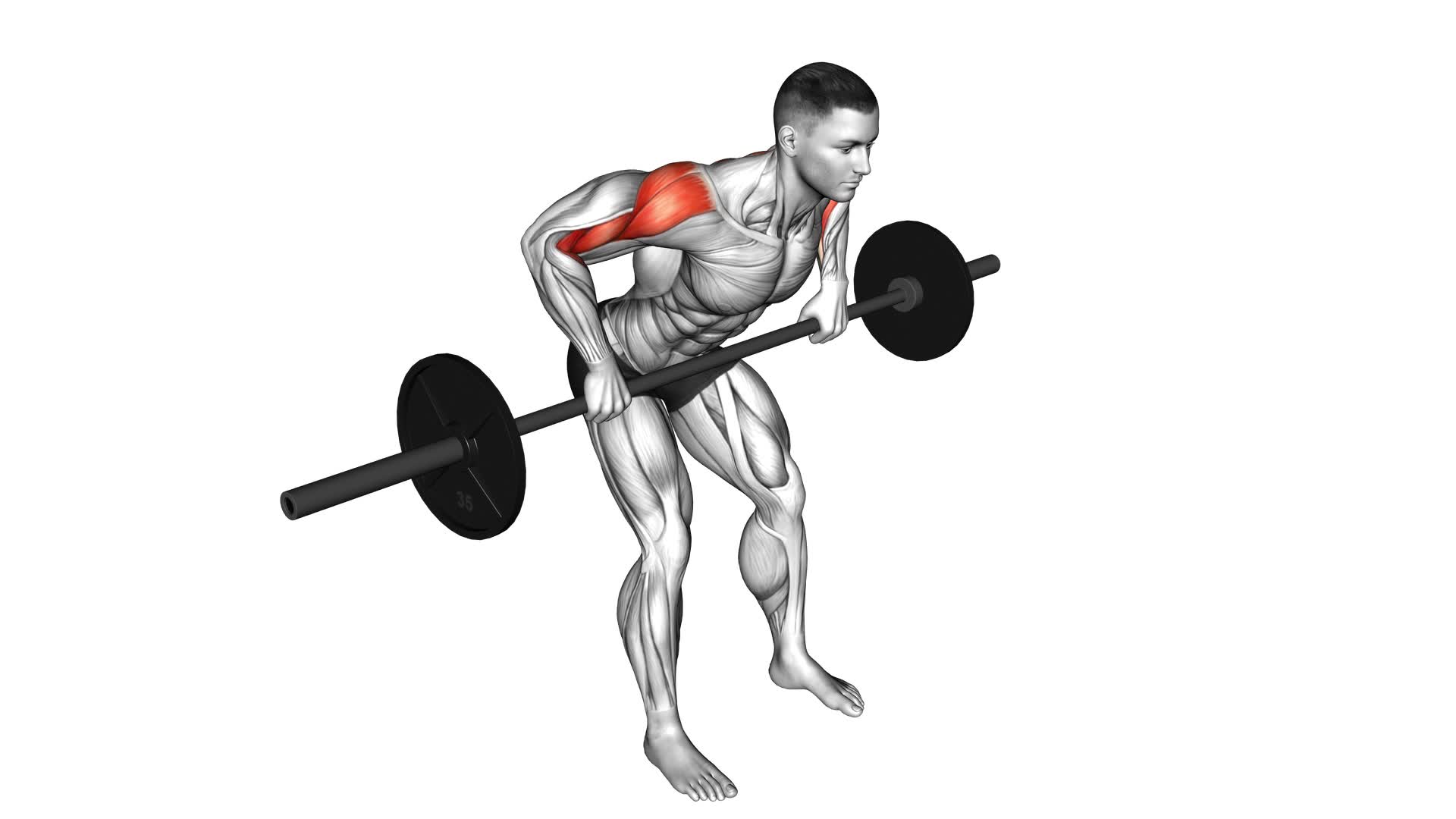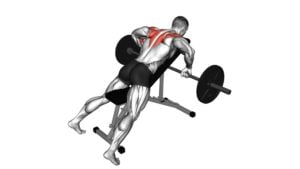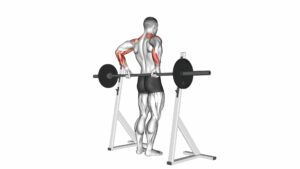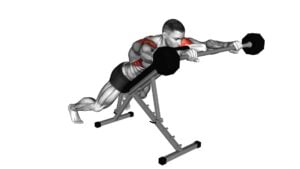Barbell Rear Delt Row – Video Exercise Guide & Tips

Are you looking to strengthen your rear deltoids? Then the barbell rear delt row is the exercise for you.
Watch This Exercise Video
In this video exercise guide, we'll show you how to perform this move with proper form and technique. You'll also find tips on choosing the right weight, variations for different fitness levels, and common mistakes to avoid.
Plus, we'll share some valuable tips for injury prevention and recovery.
Get ready to target those rear delts and achieve your fitness goals!
Key Takeaways
- Proper form and technique are essential for performing the Barbell Rear Delt Row effectively, including gripping the barbell correctly, maintaining a straight back, and pulling the barbell towards the chest while squeezing the shoulder blades together.
- Choosing the right weight is crucial to challenge the muscles without compromising form. Gradually increasing the weight over time and considering the principle of progressive overload can help improve strength.
- Different variations of the Barbell Rear Delt Row can be incorporated to target the rear delts differently and continue challenging the muscles. This includes single-arm variations, incline variations, and using resistance bands instead of a barbell.
- To prevent injuries and aid in recovery, it is important to prioritize rest, proper nutrition, and warm-up before the workout. Avoiding common mistakes such as using too much weight, rounding the back, relying on momentum, and transferring the workload to other muscle groups can also help maximize the benefits of the exercise.
Proper Form and Technique
To perform the Barbell Rear Delt Row exercise with proper form and technique, start by gripping the barbell with an overhand grip and bending your knees slightly. Stand with your feet shoulder-width apart and your back straight. Now, it's time to focus on your breathing. Inhale deeply before you begin the movement and exhale as you pull the barbell towards your body. This proper breathing technique will help you maintain control and stability throughout the exercise.
The target muscles of the Barbell Rear Delt Row are primarily the rear delts, which are the muscles located at the back of your shoulders. Additionally, this exercise also engages the muscles in your upper back, including the rhomboids and trapezius. By performing this exercise correctly, you'll be able to effectively strengthen and develop these muscles.
As you start the movement, keep your elbows close to your body and pull the barbell towards your chest. Focus on squeezing your shoulder blades together to engage your rear delts. Hold the contraction for a second and then slowly release the barbell back to the starting position. Remember to maintain control and avoid using momentum to perform the exercise.
Choosing the Right Weight
To choose the right weight for the Barbell Rear Delt Row exercise, focus on selecting a weight that challenges your muscles while still allowing you to maintain proper form and technique. It's important to find a weight that's neither too heavy nor too light. Using a weight that's too heavy can put unnecessary strain on your muscles and increase the risk of injury. On the other hand, using a weight that's too light won't provide enough resistance to effectively stimulate muscle growth.
Before starting your Barbell Rear Delt Row workout, it's essential to warm up properly. This will help prepare your muscles for the upcoming exercise and reduce the risk of injury. Begin with a few minutes of light cardio, such as jogging or cycling, to increase blood flow to the muscles. Follow this with some dynamic stretches, focusing on the muscles you'll be targeting during the exercise.
When choosing the weight, consider the principle of progressive overload. This means gradually increasing the weight over time to continue challenging your muscles and promoting growth. Start with a weight that allows you to perform the exercise with proper form for the desired number of repetitions. As you become stronger and more comfortable with the movement, gradually increase the weight to continue pushing your muscles to new limits.
Variations for Different Fitness Levels
As you progress in your fitness journey, there are various variations of the Barbell Rear Delt Row exercise that you can incorporate to cater to different fitness levels. These modified exercises and progression options will help you continue challenging your muscles and improving your overall strength and fitness.
Here are three variations to consider:
- Single-arm Barbell Rear Delt Row: This variation allows you to focus on each side of your body individually, providing a more targeted workout for your rear delts. Hold the barbell with one hand and perform the rowing motion, keeping your back straight and engaging your core for stability.
- Incline Barbell Rear Delt Row: By adjusting the angle of the bench or using an incline bench, you can change the emphasis of the exercise. Performing the row at an incline targets your rear delts at a slightly different angle, challenging your muscles in a new way.
- Resistance Band Barbell Rear Delt Row: If you don't have access to a barbell or want to switch things up, you can use resistance bands to perform the exercise. Attach the bands to a stable anchor point, hold the handles, and row while maintaining proper form.
Incorporating these variations into your routine will help you continue making progress and avoid plateaus.
Now, let's move on to the next section and discuss some common mistakes to avoid when performing the Barbell Rear Delt Row exercise.
Common Mistakes to Avoid
When performing the Barbell Rear Delt Row exercise, it's important to be aware of common mistakes that can hinder your progress and potentially lead to injury. By avoiding these mistakes, you can maximize the benefits of the exercise and achieve better results.
One common mistake is using too much weight. While it may be tempting to load up the barbell, using excessive weight can compromise your form and increase the risk of injury. Start with a weight that allows you to maintain proper technique throughout the movement.
Another mistake to avoid is rounding your back. This can put unnecessary strain on your spine and decrease the effectiveness of the exercise. Keep your back straight and engage your core muscles to maintain a stable and strong posture throughout the movement.
It is also important to avoid using momentum to lift the weight. This can take the focus away from your rear deltoids and transfer it to other muscle groups. Instead, focus on using a controlled and deliberate motion, squeezing your shoulder blades together at the top of the movement to fully activate your rear deltoids.
Tips for Injury Prevention and Recovery
To prevent injuries and aid in recovery, prioritize rest and proper nutrition after performing Barbell Rear Delt Rows. Here are some injury prevention and recovery tips to help you stay safe and optimize your results:
- Warm-up: Before starting your workout, it's important to warm up your muscles and joints to reduce the risk of injury. Spend a few minutes performing dynamic stretches and light cardio exercises to increase blood flow and flexibility.
- Use proper form: Maintaining proper form during Barbell Rear Delt Rows is essential for preventing injuries. Keep your back straight, engage your core, and avoid using momentum to lift the weight. Focus on squeezing your shoulder blades together as you pull the barbell towards your chest.
- Gradually increase intensity: As you progress with your training, gradually increase the intensity of your workouts. Pushing yourself too hard too soon can lead to overuse injuries. Listen to your body and give yourself time to recover between sessions.
Frequently Asked Questions
How Often Should I Perform the Barbell Rear Delt Row Exercise?
To determine the frequency at which you should perform the barbell rear delt row exercise, consider your fitness goals and current weightlifting routine.
This exercise targets the rear deltoid muscles, so incorporating it into your workouts 2-3 times per week can be beneficial.
Start with a weight that challenges you but allows for proper form. Gradually increase the weight as your strength improves.
Remember to consult with a fitness professional to ensure you're using the correct technique and weight for your specific needs.
Can I Substitute the Barbell With Dumbbells for the Rear Delt Row?
Yes, you can definitely substitute the barbell with dumbbells for the rear delt row exercise.
This variation is a great way to target your rear delts and build upper body strength.
To perform the dumbbell rear delt row, simply hold a dumbbell in each hand, hinge at the hips, and pull the dumbbells towards your chest while keeping your elbows close to your body.
This exercise provides a similar movement pattern and benefits as the barbell version.
Should I Feel a Burn in My Shoulders During the Exercise?
During the exercise, you should feel a burn sensation in your shoulders if you're performing it correctly. This is because the barbell rear delt row specifically targets and engages the muscles in your shoulders.
To ensure you feel the burn in the right place, make sure you maintain proper form throughout the exercise. Keep your back straight, pull the barbell towards your chest using your rear delts, and squeeze your shoulder blades together at the top of the movement.
Is It Normal to Experience Some Muscle Soreness After Performing the Barbell Rear Delt Row?
Yes, it's normal to experience some muscle soreness after performing the barbell rear delt row. This exercise targets the rear deltoid muscles, which are located in your shoulders. When you perform the exercise with proper form and challenging weight, it can cause micro-tears in the muscle fibers.
This leads to muscle soreness. To aid in muscle recovery, make sure to rest and properly fuel your body with nutritious food and hydration.
Can the Barbell Rear Delt Row Exercise Help Improve Posture?
The barbell rear delt row is one of the best exercises for improving posture. By targeting the rear deltoid muscles, it helps to strengthen and stabilize the upper back and shoulders.
This exercise is particularly effective in correcting rounded shoulders and forward head posture.
Conclusion
In conclusion, the barbell rear delt row is an effective exercise for targeting the muscles in your upper back and shoulders.
By following proper form and technique, choosing the right weight, and incorporating variations for different fitness levels, you can maximize the benefits of this exercise.
Remember to avoid common mistakes, prioritize injury prevention, and allow for proper recovery.
Incorporating the barbell rear delt row into your workout routine can help improve your overall upper body strength and posture.

Author
Years ago, the spark of my life’s passion ignited in my mind the moment I stepped into the local gym for the first time. The inaugural bead of perspiration, the initial endeavor, the very first surge of endorphins, and a sense of pride that washed over me post-workout marked the beginning of my deep-seated interest in strength sports, fitness, and sports nutrition. This very curiosity blossomed rapidly into a profound fascination, propelling me to earn a Master’s degree in Physical Education from the Academy of Physical Education in Krakow, followed by a Sports Manager diploma from the Jagiellonian University. My journey of growth led me to gain more specialized qualifications, such as being a certified personal trainer with a focus on sports dietetics, a lifeguard, and an instructor for wellness and corrective gymnastics. Theoretical knowledge paired seamlessly with practical experience, reinforcing my belief that the transformation of individuals under my guidance was also a reflection of my personal growth. This belief holds true even today. Each day, I strive to push the boundaries and explore new realms. These realms gently elevate me to greater heights. The unique combination of passion for my field and the continuous quest for growth fuels my drive to break new ground.



